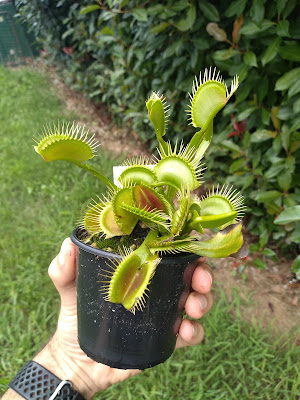I recently got a lovely variegated tiger fern. Tiger fern is a variegated variety of the Boston fern. There aren't a huge number of different types of variegated ferns, which is too bad because I think that variegated ferns usually look really nice.
For some reason that I am unable to find out, I am told that Nephrolepis exaltata and all of its varieties does not form viable spores and can only be reproduced asexually. I would love to know more about why this is the case, but I have been unable to find out anything.
Something I find remarkable is even though this species does not produce viable spores there are dozens of cultivars of it. It seems to throw natural mutations from time to time, and many new varieties have formed naturally and spontaneously.
 |
Tiger fern have variegated fronds
|
I find the history of the tiger fern to be interesting. As they can not be sexually reproduced they were developed by a long drawn out domino effect of naturally occurring mutations that just happened to be noticed by someone with enough wherewithal to keep them alive, propagate them, and spread them around.
Brief history of the tiger fern:
The wild type 'Sword fern' (Nephrolepis exaltata) has upright fronds and looks like the type of fern you would find in a woodland. The wild type existed for millennia, it was noticed by collectors and has been propagated and grown by gardeners across the world.
The 'Boston fern' (Nephrolepis exaltata ‘Bostoniensis’) came about as a natural mutation that occurred in sword ferns. Sword ferns have upright fronds, while the Boston fern has gracefully arching fronds. The arching fronds mutation was noticed in one plant among an importation
of about 200 sword ferns by a florist near Boston in 1895. This mutant plant was grown and cared for as it was a beautiful oddity. Since then the Boston fern has been propagated asexually and spread across the world by gardeners and collectors.
‘Tiger Fern' is a natural mutation of the Boston fern. The Tiger fern came about as a natural mutation that occurred in Bogor,
Indonesia, in the spring of the year 2000. Since then Tiger ferns have
been propagated asexually and spread across the world by gardeners and collectors.
To be clear, the tiger fern is not the only mutation to have occurred in Boston ferns, nor was it the first mutation to have be found in Boston ferns. There are literally dozens of varieties of Boston fern, all have arisen spontaneously and have been noticed by someone who grew them and spread them around to other interested people.
 |
Tiger fern
|
The tiger fern is noticeably different from its Boston fern parent. The following description of a tiger fern has been copied from google patents:
The following
traits have been repeatedly observed and are determined to be the
unique characteristics of ‘Tiger Fern’. These characteristics in
combination distinguish ‘Tiger Fern’ as a new and distinct cultivar of Nephrolepis Fern:
1. Upright and outwardly arching plant habit.
2. Vigorous growth habit.
3. Durable rachis; plants resist breakage during shipping.
4. Green and yellow green variegated pinnae.
5. Closely-spaced pinnae; densely foliated.
 |
Tiger fern stolons
|
As mentioned, Tiger ferns reputedly do not produce viable spores. I am not sure if they are completely infertile, or is a small percentage of spores can be viable under the correct conditions. This means that tiger ferns can only be reproduced using asexual methods.
One method of propagating these is through the use of stolons. Stolons, or runners, function the same way as strawberry runners. The plant sends out long thin stolons that can produce a baby plant where they touch the soil, and stolons may even produce baby plants while they are hanging in the air. I have heard of people removing the stolons and using the them like cuttings, while most people leave them attached to the plant and allow them to do their thing.
My little tiger fern came with a few stolons. Some were damaged and won't produce plants, whereas others look healthy and may produce new plants in time. As the plant grows I am sure it will throw more stolons when the time is right.
After only growing this tiger fern for two months it produced three baby ferns. Meaning this fern should be quite productive and quickly fill out it's pot.
 |
Tiger fern runners
|
Another way to propagate tiger ferns is to split a larger plant into several small plants. My plant is still pretty small, so this is not yet an option. I have little doubt that my variegated tiger fern will be large enough to split in spring.
From what I have seen, splitting a larger tiger fern into several plants is pretty simple. Most people just remove the fern from the pot, then use a knife and hack the thing into a bunch of pieces. I am told that Spring is the best time for this as the plant is actively growing and the plants each have a full growing season to establish before winter comes.
 |
Variegated tiger fern frond
|
Tiger ferns, like many ferns, do not love frost and do not love too much direct sunlight. They do best in bright indirect light. They like water but not being waterlogged, and they seem to do better with drier soil than many ferns.
I have a few places to grow them that may suit these ferns. I have the greenhouse that I feel may be too bright, I have a place on the deck that only receives an hour or so of morning sun that I think may be ideal, and I have limited spaces inside the house which I think may be too dark. I regret not getting two tiger ferns, that way I could have grown them under different conditions and hopefully found the best way to grow them.




















































